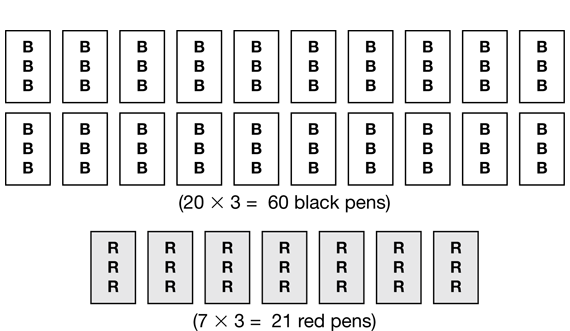Share this story problem with the class:
- Mara's teacher has 27 packages of pens. Each package contains 3 pens. 20 of the packages have black pens and 7 of the packages have red pens. How many pens are there altogether?
- Write a number sentence to match this story. (27 × 3 or 20 × 3 + 7 × 3)
- How is one of the factors broken apart? (27 is broken into 20 and 7.)
- Estimate 27 × 3. (Possible response: 30 × 3 is close to 27 × 3. 30 + 30 + 30 = 90. An answer of a little less than 90 is reasonable.)
- Let's draw a simple picture that matches the story. (Record a student's idea. See Figure 6 for an example.)
- Use a rectangle model or Mara's method to solve 27 × 3. Include number sentences.
When their work is complete, choose a student who used a rectangle model to share his or her solution. See Figure 7.
As the student shares his or her work, ask:
- Is [student name]'s answer reasonable? How do you know?
- How does [student name]'s rectangle match the story? (The large 20 × 3 rectangle matches the 20 packages of black pens. The 7 × 3 rectangle matches the 7 packages of red pens. The whole rectangle, 27 × 3, shows how many pens there are altogether.)
Now choose a student who used the all-partials algorithm to share his or her solution. See Figure 8.
Ask the meaning of the numbers they write down:
- How does each line in [student name]'s solution match the story and the drawing? (21 means the number of red pens, 7 packages × 3 red pens in each. 60 means the number of black pens, 20 packages × 3 black pens in each. 81 is the total number of pens.)
- Is [student name]'s answer reasonable? How do you know?
- How are the two methods similar? (They both break apart products into tens and ones to make multiplication easier. They both find the same answer to the problem.)
- Which method do you prefer? Why?














